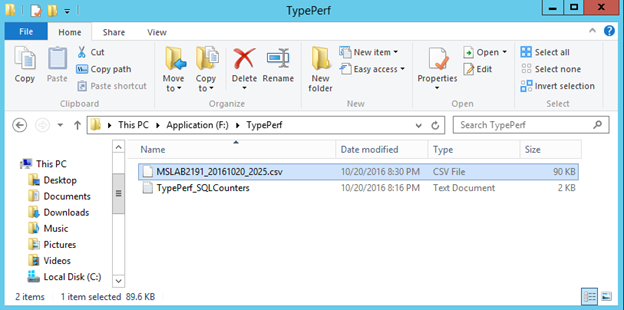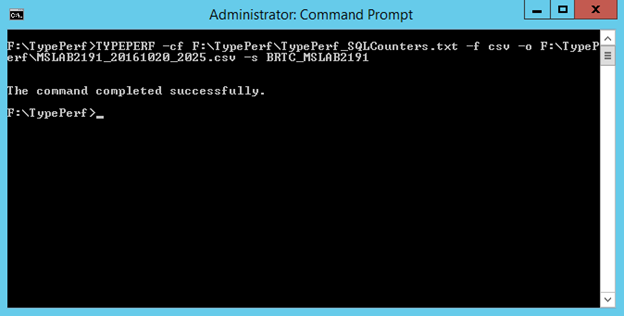转载自工作伙伴Garrett, Helen “SQL Server Performance Counter captures”
Capturing Windows Performance Counters for SQL Server
SQL Server Performance Counters
The following counters are the recommended list to capture baseline performance metrics for SQL Server:
- Memory Available Mbytes (already added above)
- Memory Page Faults/sec (already added above)
- Memory Page Reads/sec (already added above)
- Memory Page Writes/sec (already added above)
- Paging File % Usage (_Total) (already added above)
- Processor % Privileged Time (_Total)
- Processor % Processor Time (_Total)
- Processor % User Time (_Total)
- Physical Disk % Idle Time (_Total)
- Physical Disk Avg. Disk Queue Length (_Total)
- Physical Disk Avg. Disk sec/Read (_Total)
- Physical Disk Avg. Disk sec/Transfer (_Total)
- Physical Disk Avg. Disk sec/Write (_Total)
- SQL Server: Access Methods/Page Splits/sec
- SQL Server: Buffer Manager Buffer Cache Hit Ratio
- SQL Server: Buffer Manager Page Life Expectancy
- SQL Server: Buffer Manager Page Lookups/sec
- SQL Server: Buffer Manager Page Reads/sec
- SQL Server: Buffer Manager Page Writes/sec
- SQL Server: General Statistics User Connections
- SQL Server: Memory Manager Memory Grants Pending
- SQL Server: SQL Statistics Batch Requests/sec
- SQL Server: SQL Statistics SQL Compilations/sec
- SQL Server: SQL Statistics SQL Recompilations/sec
- SQL Server: Wait Statistics Memory Grant Queue Waits <all instances>
- SQL Server: Wait Statistics Network IO Waits <all instances>
- SQL Server: Wait Statistics Non-Page Latch Waits <all instances>
- SQL Server: Wait Statistics Page IO Latch Waits <all instances>
- SQL Server: Wait Statistics Page Latch Waits <all instances>
- System Processor Queue Length
TypePerf
Microsoft provides a command line utility “TypePerf” which allows capturing counters from a remote system to a monitoring system and logging these either to the command window or a log file.
More information about the TypePerf command can be found at:
https://www.microsoft.com/resources/documentation/windows/xp/all/proddocs/en-us/nt_command_typeperf.mspx?mfr=true
Using TypePerf with an Input File
Create a folder on the monitoring server named “TypePerf”.
Create a new file in the TypePerf folder named TypePerf_SQLCounters.txt.
Edit the TypePerf_SQLCounters.txt file by copying the following contents into the file:
\SERVERNAMEMemoryAvailable Bytes
\SERVERNAMEMemoryPage Reads/sec
\SERVERNAMEMemoryPage Writes/sec
\SERVERNAMEPaging File(_Total)\% Usage
\SERVERNAMEPhysicalDisk(_Total)\% Disk Time
\SERVERNAMEPhysicalDisk(_Total)Avg. Disk Queue Length
\SERVERNAMEPhysicalDisk(_Total)Avg. Disk sec/Read
\SERVERNAMEPhysicalDisk(_Total)Avg. Disk sec/Transfer
\SERVERNAMEPhysicalDisk(_Total)Avg. Disk sec/Write
\SERVERNAMEProcessor(_Total)\% Privileged Time
\SERVERNAMEProcessor(_Total)\% Processor Time
\SERVERNAMEProcessor(_Total)\% User Time
\SERVERNAMESQLServer:Access MethodsPage Splits/sec
\SERVERNAMESQLServer:Buffer ManagerBuffer cache hit ratio
\SERVERNAMESQLServer:Buffer ManagerPage life expectancy
\SERVERNAMESQLServer:Buffer ManagerPage lookups/sec
\SERVERNAMESQLServer:General StatisticsUser Connections
\SERVERNAMESQLServer:Memory ManagerMemory Grants Pending
\SERVERNAMESQLServer:SQL StatisticsBatch Requests/sec
\SERVERNAMESQLServer:SQL StatisticsSQL Compilations/sec
\SERVERNAMESQLServer:SQL StatisticsSQL Re-Compilations/sec
\SERVERNAMESQLServer:Wait Statistics(*)Memory grant queue waits
\SERVERNAMESQLServer:Wait Statistics(*)Network IO waits
\SERVERNAMESQLServer:Wait Statistics(*)Page IO latch waits
\SERVERNAMESQLServer:Wait Statistics(*)Page latch waits
\SERVERNAMESystemProcessor Queue Length

Perform a global replace of the SERVERNAME to match the actual server name for the SQL Server that is to be monitored. Save the file and Close.
--------------------------------------------------------------分割线---------------------------------------------------------------------------
Go to the Start menu -> Command Prompt.

Change the directory to the location where the TypePerf directory was created.
At the command prompt, modify the next command to match the information for the SQL Server being monitored:
TYPEPERF -cf F:TypePerfTypePerf_SQLCounters.txt -f csv -o F:TypePerfMSLAB2191_yyyymmdd_hhmm.csv -s BRTC_MSLAB2191
-cf Name of the file that contains the list of counters to capture
-f format of the log file, defaults to csv
-o Path ame of output file
-s Name of server to collect the counters from if one does not exist in the counter file
EXAMPLE:
TYPEPERF -cf F:TypePerfTypePerf_SQLCounters.txt -f csv -o F:TypePerfMSLAB2191_20161020_2025.csv -s BRTC_MSLAB2191
Press Enter to start the counter collection…

The [] will run the command and capture the counters every second.
Verify the file you specified for the output was created and is growing:

-------------------------------------------------------分割线-----------------------------------------------------------------------
When you have completed the SQL Server test, Press CTRL-C to stop the counter collection.

Close the Command Prompt window.